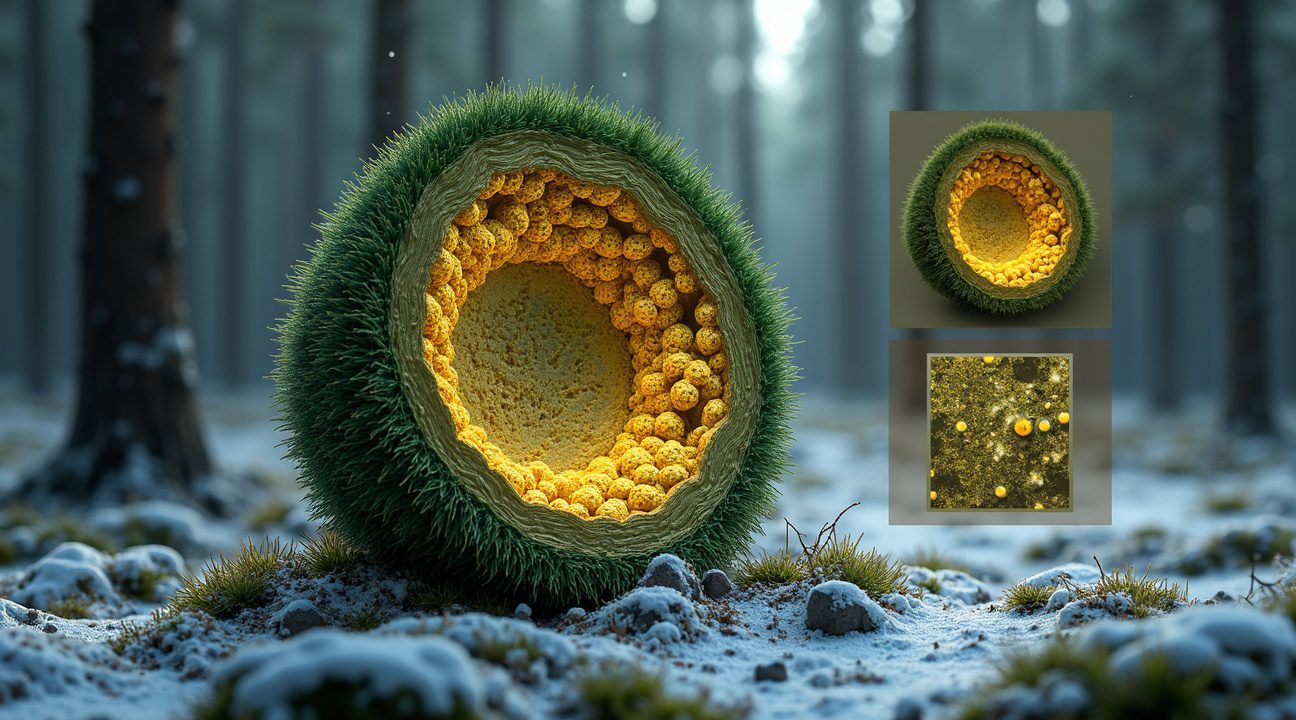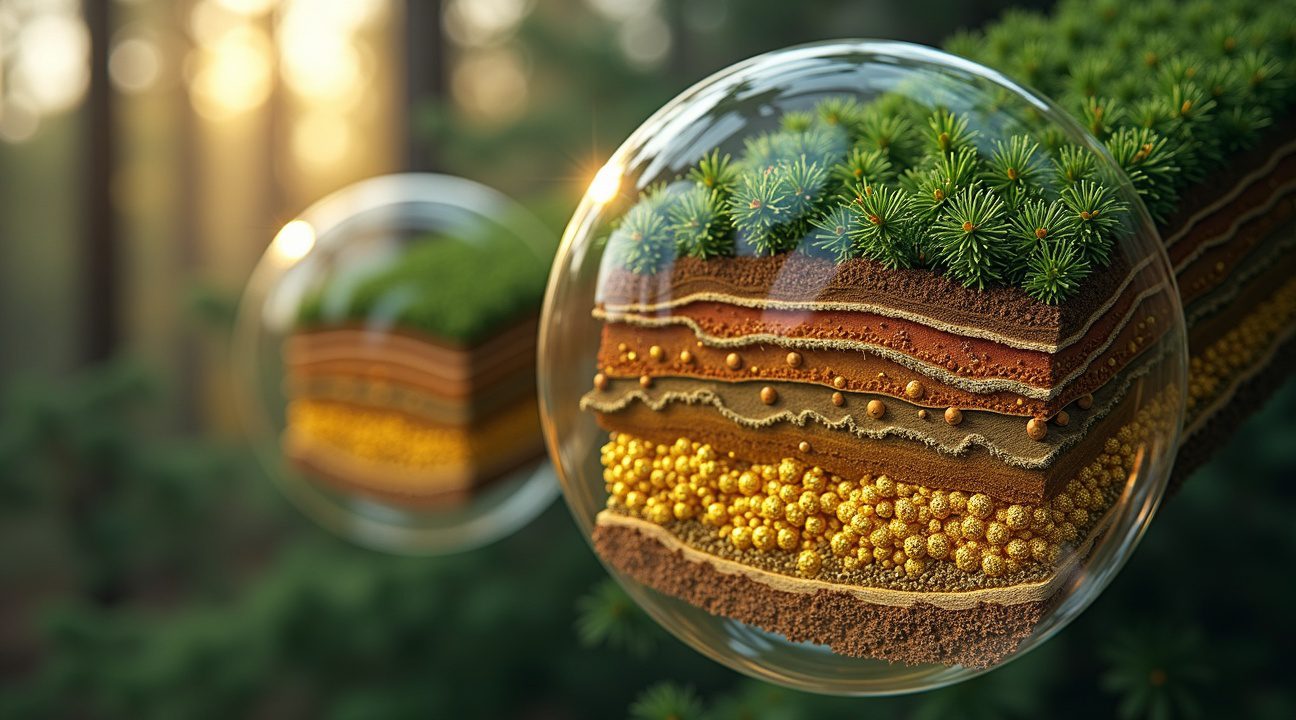Scientists in Finnish Lapland have uncovered a groundbreaking biological process that challenges conventional scientific understanding of how precious metals, particularly gold, form in nature.
Gold Formation Inside Trees
Researchers have revealed that microscopic bacteria located inside the needles of the Norway spruce have the ability to create gold nanoparticles. These bacteria transform dissolved gold ions found in soil into solid metallic gold particles, conducting this transformation within the living tissue of the trees. This marks the first conclusive evidence that gold can form inside plants through biological activity.
The Role of Bacteria
Four bacterial genera were identified as key players in this biomineralization process. These bacteria reside as endophytes—organisms that live harmlessly inside plant tissues—and appear instrumental in the production of gold particles.
- Corynebacterium
- Cutibacterium
- P3OB-42
- Methylobacterium
These microbes metabolize gold ions, facilitating their conversion into elemental gold within the cellular structure of the spruce needles.
Prevalence and Economic Impact
While the discovery is scientifically significant, the economic implications are currently limited. Researchers found that:
- 17% of tested trees contained gold particles
- Gold concentrations ranged from 0.2 to 2.8 micrograms per kilogram of dry needle matter
- Each tree holds only a few cents worth of gold
Although not currently viable for commercial mining, this biological phenomenon holds promise for future applications in mineral exploration.
Implications for Sustainable Mining
A New Approach to Exploration
Advanced analytical methods, such as electron microscopy and energy-dispersive X-ray spectroscopy, confirmed that gold is forming within the tissues of the trees—eliminating the possibility of mere surface contamination. This discovery could pave the way for innovative, sustainable mineral exploration techniques that utilize the presence of bioindicators rather than traditional excavation.
Trees could serve as natural bioindicators for underground gold deposits, making it possible to detect valuable resources without harming the environment.
Toward Eco-Friendly Prospecting
The biological formation of gold within living organisms introduces exciting new prospects for the future of mining. By working with forest ecosystems and leveraging natural processes, scientists might soon develop mining methods that are more aligned with principles of environmental sustainability.
Bacteria Transform Trees Into Living Gold Factories in Finnish Forests
Researchers from the University of Oulu and the Geological Survey of Finland have uncovered a fascinating biological phenomenon occurring deep within the forests of Finnish Lapland. These scientists confirmed that gold nanoparticles actually form inside the needles of Norway spruce (Picea abies) trees through an extraordinary partnership with microscopic bacteria.
The discovery reveals that these gold particles aren’t simply environmental contamination that settled on the tree surfaces. Instead, the precious metal forms within the needle tissue itself, consistently found in close association with microbial biofilms. This finding challenges conventional understanding of how gold distributes in natural environments and opens new possibilities for both ecological research and mineral exploration.
Microscopic Partners Drive Gold Formation
Scientists identified several specific bacterial genera responsible for this remarkable biomineralization process. These findings show that four key bacterial types contribute to gold particle formation:
- Corynebacterium – bacteria commonly found in plant tissues that facilitate metal processing
- Cutibacterium – microorganisms known for their metabolic versatility in various environments
- P3OB-42 – specialized bacterial strains with unique mineral-processing capabilities
- Methylobacterium – bacteria that excel at processing organic compounds and metals
These microbes function as endophytes, which means they live symbiotically inside plant tissues without causing harm to their host trees. The bacteria establish colonies within the needle structure, creating an internal environment where gold particles can form through natural biochemical processes.
Advanced analytical techniques provided the proof needed to confirm this discovery. Field-emission scanning electron microscopy (FE-SEM) allowed researchers to visualize the gold particles at the nanoscale level, while energy-dispersive X-ray spectroscopy (EDS) definitively identified the elemental composition of these formations. The combination of these technologies revealed that the gold exists as discrete nanoparticles embedded within the living tissue matrix.
The biomineralization process appears to occur when these bacterial communities interact with trace amounts of gold dissolved in groundwater that the trees absorb through their root systems. The endophytic bacteria concentrate and transform these minute gold quantities into solid nanoparticles through their metabolic activities. This biological gold concentration mechanism operates continuously as long as the bacterial communities remain active within the tree tissues.
This discovery has significant implications for understanding how scientists think about mineral formation in natural environments. The Norway spruce trees essentially function as living gold factories, with their bacterial partners serving as microscopic miners and refiners. The process represents a completely natural form of nanotechnology that has likely been occurring undetected for thousands of years.
Finnish Lapland’s unique geological conditions create ideal circumstances for this phenomenon. The region’s mineral-rich soils and specific climate patterns support both the Norway spruce populations and their bacterial symbionts. The trees’ ability to absorb and concentrate trace metals from their environment, combined with the specialized metabolic capabilities of their endophytic bacteria, creates perfect conditions for gold nanoparticle formation.
The research methodology employed by the University of Oulu team establishes a new standard for investigating biomineralization processes in forest ecosystems. Their systematic approach to identifying both the bacterial communities and the resulting mineral formations provides a template for future studies examining similar phenomena in other tree species and geographic regions.
These findings suggest that Norway spruce trees could potentially serve as biological indicators for gold deposits in the surrounding soil. The presence of gold nanoparticles in needle tissue might signal larger mineral concentrations in the area, offering a sustainable approach to mineral exploration that doesn’t require invasive drilling or excavation techniques.
The bacterial transformation of these trees into living gold repositories represents a previously unknown biological pathway for precious metal concentration.

How Microscopic Alchemists Create Gold Inside Living Trees
Finland’s Norway spruce trees perform an extraordinary feat through their partnership with tiny bacterial residents. These microscopic organisms act as natural alchemists, transforming dissolved gold ions from soil water into actual metallic nanoparticles within living tree tissues.
The Biomineralization Process
Trees naturally absorb water containing dissolved gold ions from the surrounding soil through their root systems. Endophytic bacteria living inside the trees then facilitate a sophisticated process called biomineralization. These bacterial communities convert the ionic gold into metallic nanoparticles that become permanently embedded within the tree’s cellular structure.
This microbial biofilm activity represents a remarkable example of biological mineral uptake. The bacteria essentially engineer conditions inside the tree that allow gold ions to transform into solid metal particles. Scientists have confirmed this process occurs specifically within the needle tissues of Norway spruce trees in Finnish Lapland.
Bacterial Communities and Gold Formation
Genetic sequencing studies reveal fascinating patterns in how bacterial communities relate to gold formation. Researchers found that gold-positive needles actually contained fewer total bacterial species than gold-free needles, suggesting a specialized microbial environment. However, the overall community composition and diversity remained remarkably similar between gold-containing and gold-free samples.
Indicator species analysis provided crucial evidence for this biological gold-making process. Scientists identified specific bacterial taxa that showed distinctive associations with gold-rich samples. These findings confirm that particular bacterial strains play essential roles in the biomineralization process.
The discovery challenges traditional understanding of how precious metals interact with living organisms. While scientists think they’ve discovered many biological mysteries, this process represents something entirely unique in nature. Unlike simple absorption or accumulation, these endophytes actively transform the chemical structure of gold itself.
This bacterial alchemy occurs continuously within living trees, creating microscopic gold deposits that persist within the needle tissues. The process doesn’t harm the trees and appears to be a natural adaptation that has likely existed for thousands of years in these northern forests. Scientists continue studying how environmental factors influence this remarkable partnership between trees and their microscopic gold-making partners.

One in Six Trees Contains Hidden Gold Treasure
Finnish scientists have uncovered a remarkable pattern in their extensive analysis of Norway spruce trees across Lapland. Out of 138 needle samples collected from 23 different trees, researchers discovered gold nanoparticles in exactly 4 individual specimens. This finding translates to approximately 17% of the tested trees harboring these precious metal deposits within their needles.
Microscopic Quantities with Precise Measurements
The gold concentrations detected in these extraordinary trees varied significantly across samples. Measurements revealed a range from 0.2 to 2.8 micrograms per kilogram of dry needle material. Scientists achieved these precise readings using advanced analytical techniques capable of detecting even the smallest traces of precious metals.
To put these numbers into perspective, a typical mature Norway spruce carries between 50 and 60 kilograms of dry needle biomass. Using the highest recorded concentration of 2.8 micrograms per kilogram, researchers calculated that a single tree could theoretically contain up to 168 micrograms of gold. While this discovery represents a fascinating biological phenomenon, the economic reality proves far less exciting than one might initially imagine.
Economic Realities of Tree-Based Gold
The commercial value of gold found within these spruce needles amounts to mere pennies per tree. Current gold prices place 168 micrograms at a worth of only a few cents, making any harvesting operation completely uneconomical. I find it intriguing how scientists think about these discoveries differently than treasure hunters might expect.
Several factors contribute to the impractical nature of extracting this biological gold:
- Processing costs would far exceed the value of recovered material
- Extraction methods would require sophisticated laboratory equipment
- Environmental impact would be disproportionate to financial gain
- Time investment wouldn’t justify the minimal returns
The statistical data from this research provides valuable insights into how gold distribution occurs naturally within forest ecosystems. Scientists observed that the 17% occurrence rate suggests specific environmental conditions must align for gold accumulation to happen. These conditions likely involve particular soil compositions, root system interactions, and the presence of specific bacterial strains capable of processing metallic compounds.
Interestingly, the variation in gold concentrations between different trees indicates that individual specimens possess varying capacities for metal uptake and storage. Some trees demonstrated significantly higher accumulation rates than others, even when growing in similar environmental conditions. This variation suggests that genetic factors or specific microbial partnerships might influence a tree’s ability to concentrate gold particles.
The research methodology involved careful sampling techniques to ensure accurate measurements across different tree specimens. Scientists collected needle samples from various heights and orientations on each tree to account for potential differences in gold distribution throughout the canopy. Laboratory analysis required specialized equipment capable of detecting these incredibly small quantities of precious metal.
These findings contribute to broader scientific understanding of how plants interact with trace metals in their environment. Rare footage of natural phenomena often captures public attention, but this discovery represents something equally remarkable happening at a microscopic level within living trees.
The bacterial role in this process remains particularly fascinating to researchers. These microscopic organisms appear to facilitate the conversion of ionic gold from soil into nanoparticles that become incorporated into plant tissue. Understanding this biological mechanism could lead to applications in biotechnology or environmental remediation, even if direct gold harvesting remains economically unfeasible.
Future research will likely focus on identifying the specific bacterial species responsible for this gold concentration process and determining optimal environmental conditions that promote higher accumulation rates.

Trees Could Revolutionize How We Find Hidden Gold Deposits
I discovered something remarkable happening in the forests of Finnish Lapland that could transform how mining companies search for precious metals. These Norway spruce trees aren’t just standing above gold deposits – they’re actively forming gold particles inside their needles through microscopic bacteria, creating a living detection system for hidden mineral wealth.
Living Indicators Point to Buried Treasure
These trees and their tiny bacterial partners have developed into natural bioindicators that reveal what lies beneath the forest floor. The bacteria living within spruce needles concentrate gold particles in ways that mirror the mineral deposits deep underground. This relationship works so effectively that sampling tree needles can pinpoint gold reserves without disturbing a single square meter of soil.
The breakthrough becomes even more significant when I consider the location of these discoveries. Research sites in Lapland sit directly above established gold deposits, including the Kittilä mine, which stands as Europe’s largest gold producer. Scientists found higher concentrations of gold-accumulating bacteria in trees growing above known mineral zones compared to those in areas without gold deposits.
This correlation suggests that trees essentially function as massive biological sensors, extending their root systems deep enough to encounter traces of underground gold and then concentrating these particles through bacterial processes in their needles. Much like how some individuals possess extraordinary sensory abilities, these trees demonstrate an unexpected capacity to detect and respond to their mineral environment.
Sustainable Prospecting Through Natural Systems
Traditional mineral exploration requires heavy machinery, extensive drilling, and significant environmental disruption. This new approach flips that model entirely by working with existing forest ecosystems rather than against them. Companies could screen needle samples across vast forested areas to identify the most promising locations before committing to any invasive exploration techniques.
The environmental impact reduction could be substantial:
- Forests remain intact during initial survey phases
- Needle sampling causes minimal disturbance compared to drilling
- Accurate targeting of gold-rich zones before excavation
Mining operations increasingly face pressure to minimize their environmental footprint, making this discovery particularly timely. The technique offers a way to maintain sustainable prospecting practices while potentially reducing exploration costs and timeframes. Forest ecosystems remain intact during the initial survey phase, preserving biodiversity and carbon storage capacity.
The scientific applications extend beyond simple gold detection. Researchers believe similar bacterial relationships might exist for other metals, opening possibilities for detecting copper, silver, or rare earth elements through tree analysis. This could revolutionize how companies approach mineral exploration in forested regions worldwide.
Early studies indicate:
- Different bacterial species might concentrate different metals
- Distinct detection systems may exist across ecosystems
- Potential for simultaneous multi-metal detection through targeted needle analysis
The method’s precision continues to improve as scientists better understand the relationship between bacterial concentrations and deposit sizes. Initial results suggest that bacterial density correlates with the richness of underlying gold deposits, potentially allowing companies to estimate reserve sizes before conducting expensive subsurface exploration.
This discovery represents a fundamental shift from destructive exploration methods toward partnership with natural systems. Trees that have grown above gold deposits for decades already contain the information mining companies need. The challenge now lies in scaling up analysis techniques and developing standardized protocols for different forest types and geographical regions.
The implications extend beyond immediate commercial applications. This research demonstrates how scientific discoveries can emerge from unexpected sources, revealing that answers to human challenges often exist within natural systems we’re only beginning to understand.

First Study Proves Gold Forms Inside Trees Rather Than Just On Surface
Previous research had suggested that plants could harbor gold, particularly studies examining eucalyptus trees in Australia that showed traces of the precious metal. However, those investigations couldn’t definitively determine whether gold deposits formed within plant tissues or simply accumulated on external surfaces from environmental contamination.
The Finnish research team’s groundbreaking work represents the first scientific confirmation that gold actually precipitates inside living plant tissue. Using advanced high-resolution imaging techniques, the scientists documented gold nanoparticles forming within the cellular structure of Norway spruce needles themselves. This discovery fundamentally changes how researchers understand the relationship between plants and precious metals.
Advanced Imaging Reveals Internal Gold Formation
The research team employed sophisticated analytical methods to prove their findings beyond doubt. Key techniques included:
- Electron microscopy to visualize gold particles at the cellular level
- Energy-dispersive X-ray spectroscopy to confirm the chemical composition of detected particles
- Tissue analysis comparing internal cellular structures with external surface deposits
- High-resolution imaging that distinguished between contamination and actual biological formation
These scientific breakthrough methods allowed researchers to observe gold nanoparticles embedded within the needle tissues rather than merely coating the surface. The imaging revealed that bacterial communities living symbiotically within the spruce trees actively participate in precipitating gold from trace amounts present in soil and groundwater.
The bacterial role proves particularly fascinating because these microorganisms can process dissolved gold ions and convert them into solid metal particles through their metabolic processes. Unlike previous scientific discoveries that relied on observation alone, this study demonstrates an active biological mechanism.
This internal formation process differs dramatically from surface accumulation, where environmental factors might deposit gold particles on plant exteriors. The Finnish team’s tissue analysis showed gold particles integrated into the cellular matrix itself, proving that living trees can function as biological gold factories. The discovery opens new possibilities for understanding how natural phenomena create unexpected results through microscopic processes.
Energy-dispersive X-ray spectroscopy confirmed that the detected particles contained pure gold rather than gold-containing compounds, establishing that the bacterial communities successfully reduce gold ions to metallic form. This biological precipitation represents an entirely new category of gold formation that could revolutionize both geological understanding and potential extraction methods.
Environmental Benefits Point Toward Sustainable Mining Future
The groundbreaking discovery in Finnish Lapland presents an exciting opportunity to transform how scientists approach mineral exploration through environmental microbiome applications. Traditional gold prospecting methods often involve destructive techniques that disrupt ecosystems and leave lasting environmental scars. This bacterial-driven process inside Norway spruce needles offers a completely different path forward.
The natural nanoparticle formation occurring within these trees demonstrates nature’s own efficient mining system at work. Microscopic bacteria facilitate gold accumulation without requiring heavy machinery, chemical processing, or landscape destruction. I find this biological approach particularly compelling because it harnesses existing ecological processes rather than fighting against them.
Revolutionary Applications in Mineral Exploration
Scientists can now explore several promising applications that could reshape sustainable mining practices:
- Using spruce needles as natural biomarkers to identify gold-rich areas without invasive drilling or excavation
- Developing bacterial cultivation techniques that could concentrate mineral resources in controlled environments
- Creating biological prospecting methods that work alongside forest ecosystems rather than destroying them
- Establishing tree-based monitoring systems that provide ongoing data about subsurface mineral deposits
- Implementing microbiome-guided exploration that reduces the need for extensive land disturbance
This biological mineral exploration system could significantly reduce the carbon footprint associated with traditional gold prospecting. Rather than clearing vast areas and using energy-intensive equipment, researchers could potentially map gold deposits by analyzing needle samples from existing forests. The bacteria perform the concentration work naturally, eliminating many steps that typically require substantial energy input.
The research also opens doors for understanding how other trees and their resident microorganisms might interact with different mineral resources. Scientists studying cognitive phenomena have shown how unexpected discoveries often lead to broader applications across multiple fields. This gold-forming bacterial process could represent just the beginning of microbiome-based resource management.
Environmental microbiome research extends beyond simple mineral detection. The bacterial communities living within Norway spruce needles might serve as indicators of overall ecosystem health and mineral availability. This dual-purpose monitoring system could help scientists track both environmental conditions and resource potential simultaneously.
The nanoparticle formation process happening inside these needles also suggests possibilities for biotechnology applications. Scientists could potentially cultivate these bacteria in laboratory settings to create controlled gold accumulation systems. Such approaches might eventually lead to urban mining operations that produce precious metals without environmental destruction.
Current sustainable mining initiatives struggle with balancing resource extraction needs against environmental protection. This bacterial discovery provides a potential bridge between these competing priorities. The naturally occurring processes demonstrate that biological systems can concentrate valuable materials efficiently while maintaining ecological balance.
Forest-based mineral exploration could also support conservation efforts by providing economic incentives to preserve wooded areas. When trees become valuable tools for resource detection, communities might find stronger motivation to protect their forests rather than clear them for development.
The implications extend to climate change mitigation as well. Traditional mining operations contribute significantly to greenhouse gas emissions through energy consumption and habitat destruction. Biological prospecting methods could dramatically reduce these impacts while still meeting society’s demand for precious metals.
Scientists working on this research emphasize that the bacterial processes represent millions of years of evolutionary optimization. These microorganisms have developed highly efficient methods for concentrating gold at the cellular level. Understanding and applying these natural processes could revolutionize how humans approach resource extraction.
The discovery also highlights the importance of preserving biodiversity for technological advancement. Each bacterial species living within these trees represents potential applications that scientists haven’t yet discovered. Maintaining healthy forest ecosystems becomes not just an environmental priority but also a technological necessity for future innovations in sustainable mining.
Sources:
Daily Galaxy – Money May Not Grow On Trees, But Scientists Just Found Gold Inside Them
SYFY – Yes, Gold Sometimes Does Grow On (or in) Trees
Live Science – Scientists Discover Gold Nanoparticles Hidden in Spruce Tree Needles
ZME Science – Money Doesn’t Grow on Trees? These Spruce Trees in Finland Are Different
Sify News – New Study Proves Gold Grows on Trees: What It Means and Why India Should Pay Attention
Interesting Engineering – Bacteria in Norway’s Spruce Tree Needles Found Hiding Gold: Study
Environmental Microbiome – (article title not provided but source identified)
One Stop ESG – Bacteria in Norway’s Spruce Tree Needles Found Hiding Gold: Study


